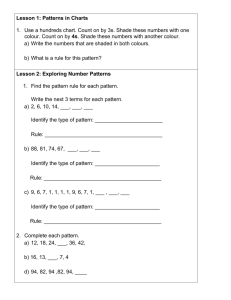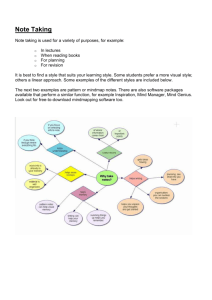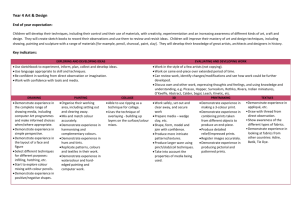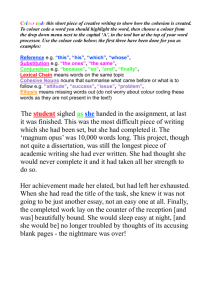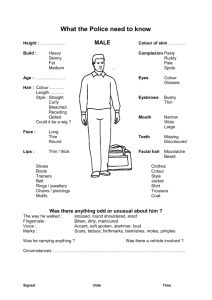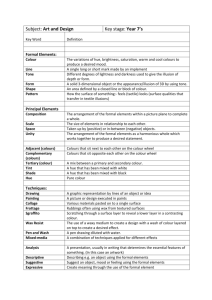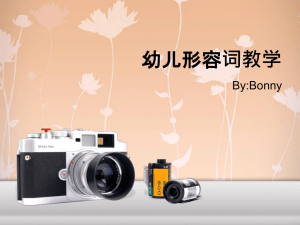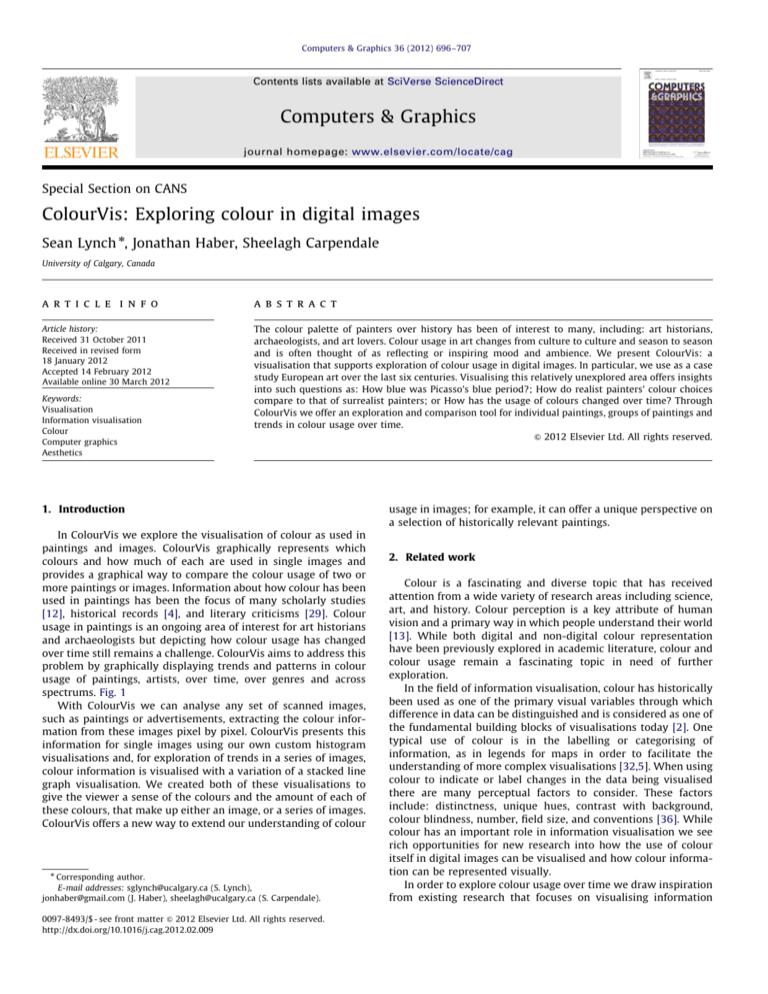
Computers & Graphics 36 (2012) 696–707
Contents lists available at SciVerse ScienceDirect
Computers & Graphics
journal homepage: www.elsevier.com/locate/cag
Special Section on CANS
ColourVis: Exploring colour in digital images
Sean Lynch n, Jonathan Haber, Sheelagh Carpendale
University of Calgary, Canada
a r t i c l e i n f o
a b s t r a c t
Article history:
Received 31 October 2011
Received in revised form
18 January 2012
Accepted 14 February 2012
Available online 30 March 2012
The colour palette of painters over history has been of interest to many, including: art historians,
archaeologists, and art lovers. Colour usage in art changes from culture to culture and season to season
and is often thought of as reflecting or inspiring mood and ambience. We present ColourVis: a
visualisation that supports exploration of colour usage in digital images. In particular, we use as a case
study European art over the last six centuries. Visualising this relatively unexplored area offers insights
into such questions as: How blue was Picasso’s blue period?; How do realist painters’ colour choices
compare to that of surrealist painters; or How has the usage of colours changed over time? Through
ColourVis we offer an exploration and comparison tool for individual paintings, groups of paintings and
trends in colour usage over time.
& 2012 Elsevier Ltd. All rights reserved.
Keywords:
Visualisation
Information visualisation
Colour
Computer graphics
Aesthetics
1. Introduction
In ColourVis we explore the visualisation of colour as used in
paintings and images. ColourVis graphically represents which
colours and how much of each are used in single images and
provides a graphical way to compare the colour usage of two or
more paintings or images. Information about how colour has been
used in paintings has been the focus of many scholarly studies
[12], historical records [4], and literary criticisms [29]. Colour
usage in paintings is an ongoing area of interest for art historians
and archaeologists but depicting how colour usage has changed
over time still remains a challenge. ColourVis aims to address this
problem by graphically displaying trends and patterns in colour
usage of paintings, artists, over time, over genres and across
spectrums. Fig. 1
With ColourVis we can analyse any set of scanned images,
such as paintings or advertisements, extracting the colour information from these images pixel by pixel. ColourVis presents this
information for single images using our own custom histogram
visualisations and, for exploration of trends in a series of images,
colour information is visualised with a variation of a stacked line
graph visualisation. We created both of these visualisations to
give the viewer a sense of the colours and the amount of each of
these colours, that make up either an image, or a series of images.
ColourVis offers a new way to extend our understanding of colour
n
Corresponding author.
E-mail addresses: sglynch@ucalgary.ca (S. Lynch),
jonhaber@gmail.com (J. Haber), sheelagh@ucalgary.ca (S. Carpendale).
0097-8493/$ - see front matter & 2012 Elsevier Ltd. All rights reserved.
http://dx.doi.org/10.1016/j.cag.2012.02.009
usage in images; for example, it can offer a unique perspective on
a selection of historically relevant paintings.
2. Related work
Colour is a fascinating and diverse topic that has received
attention from a wide variety of research areas including science,
art, and history. Colour perception is a key attribute of human
vision and a primary way in which people understand their world
[13]. While both digital and non-digital colour representation
have been previously explored in academic literature, colour and
colour usage remain a fascinating topic in need of further
exploration.
In the field of information visualisation, colour has historically
been used as one of the primary visual variables through which
difference in data can be distinguished and is considered as one of
the fundamental building blocks of visualisations today [2]. One
typical use of colour is in the labelling or categorising of
information, as in legends for maps in order to facilitate the
understanding of more complex visualisations [32,5]. When using
colour to indicate or label changes in the data being visualised
there are many perceptual factors to consider. These factors
include: distinctness, unique hues, contrast with background,
colour blindness, number, field size, and conventions [36]. While
colour has an important role in information visualisation we see
rich opportunities for new research into how the use of colour
itself in digital images can be visualised and how colour information can be represented visually.
In order to explore colour usage over time we draw inspiration
from existing research that focuses on visualising information
S. Lynch et al. / Computers & Graphics 36 (2012) 696–707
697
Fig. 1. ColourVis representation of paintings by Vincent van Gogh.
chronologically, casual information visualisations, and artistic
visualisation. Our prototype design was informed by works which
present information using a stacking metaphor such as ThemeRiver [15], which visualises the changes in text data over time using
the inspiration of a flowing river. Each current in the ‘river’
represents frequency of word or word phrase usage and is
coloured distinctly. This depiction either narrows or widens
indicating changing quantitative information about the dataset.
Subsequently, the paper Stack Graphs by Byron and Wattenberg
extended the ideas in ThemeRiver by exploring several variations
stacked layered graphs and suggested that the implementation of
complex layered graphs can be effective for displaying large
amounts data in aesthetic manner to mass audiences [7].
ColourVis is designed with the analysis of images in mind but
other researchers have explored how video data might be visualised over time and this too informed our design of ColourVis. The
Last Clock project visualised video surveillance footage in public
area capturing time and motion and then mapping seconds,
minutes, hours using the metaphor of a clock face to show data
variance over time [1]. The Video Traces Project, visualises video
data in order to gain an understanding of activity of people
captured on the video and supports rapid exploration of the
history of a video stream [24]. Also, the Artifacts of the Presence
Era visualisation make use of video as a data source but presents a
stacked graph visualisation which uses the metaphor of sedimentary accumulation over time [35]. ColourVis can also be compared
to parallel coordinates [17]. In parallel coordinates each data
dimension is given an axis and the data values are then plotted on
this axis. This has proved useful for multi-dimensional data since
each dimension can be assigned its own axes. In ColourVis each
image or group of images can be considered as an axis in parallel
coordinates. However, the ColourVis data as shown on these axes
represents percentage use of colour comparison purposes.
We also explored how tagged images have been visualised
over time. The Flickr Flow visualisation project http://hint.fm/
projects/flickr/ was developed for Wired Magazine and calculates
the relative proportions of different colours extracted from
photographs taken in each month of a year. Flickr Flow then
plots this colour data using a fluid and aesthetically pleasing
radial representation. Wired magazine also presented a visualisation to extract ‘‘peak’’ colour from any image and then produce a
bullseye pattern for each image analysed. Thisbullseye visualisation was presented by grouping many small visualisations in a
grid layout on a single page for visual inspection while the Flickr
Flow visualisation grouped the extracted image data into a single
synthesised visualisation. ColourVis adopted the approach of
synthesising many images into a single visualisation to allow
for comparison of a large number of images without the need to
compare many distinct but smaller visualisations.
2.1. The use and analysis of colour in science
Scientists have also long been interested in understanding colour.
When depicting colour scientifically there are, generally, two types of
Fig. 2. Left: various pie charts representing a series of van Gogh’s paintings by
Arthur Buxton. Right: a visualisation of the colours worn by Jacobo Zanella over a
period of one day. Reprinted by permission of the artists.
colouring: true-colouring and false-colouring. An example of truecolouring is as follows: in an image of a blue ocean, the ocean
appears to be the same colour as it would in the real world and,
likewise, an image of a red brick of a house would appear to be the
same red as it would in real life. False-colouring differs from truecolouring in that false-colour imagery alters the colour of the subject
matter to appear as a different colour than it would normally appear
to the human eye. One of the most iconic examples of false-colour
imagery are images produced by astronomers using satellite technology, such as the Hubble Space Telescope. In false-colour satellite
imagery, light spectra that are imperceptible to the human eye are
altered in order to be perceived by humans in an understandable and
visually appealing manner. Scientists also commonly observe trends
in colour change and colour shifts in order to measure things such
as the speed and distance of celestial objects, and for diagnosing
medical conditions using medical imagery.
Scientific investigations of colour have also focused on using
technologies, such as x-rays and other scanning technologies, to
more closely examine the qualities and technical properties of
pigments colours used in paintings [18]. Due to the historical
significance of some paintings, analysing pigment from a painting
in an unobtrusive and minimally impactful way has been a focus
of research for many art historians. Examples of these types of
investigations include the development of a minimally invasive
process using x-ray fluorescence spectrometry to produce a
gentle sampling technique in historical paintings and manuscripts
[20] and viewing paint colours painted under other layers of
painting in the works of Vincent van Gogh [10].
Archaeologists and historians have also examined exploring
colour in paintings. Archaeological researchers are interested in
things like the processes used to create certain colours used in
historical paintings; for example, understanding how certain shades
of blue and purple were created. Some of this curiosity stems from
the elaborate or expensive process of creating certain pigments.
Archaeologists have even attempted to replicate the historically
correct methods of processing raw ingredients required to make
rare pigments colours such as Royal Purple [23,22].
698
S. Lynch et al. / Computers & Graphics 36 (2012) 696–707
2.2. Colour visualisation in art
3.1. Visualising colour usage in one image
Most closely related to our work are Buxton’s pie chart
visualisations of Vincent van Gogh paintings that represent the
colour usage in van Gogh’s paintings [6]. In these visualisations,
similar colours from van Gogh’s paintings have been aggregated
and are represented by a single colour in order to simplify the
visualisation and make it more readable [6] (see Fig. 2). These pie
chart visualisations represent various van Gogh paintings in five
distinct colour regions or less. Rigau et al. also explored the
evolution of the colour palette and composition of van Gogh’s
style [28] by introducing measures to better understand the
changes in van Gogh’s painting style over his career.
Besides in paintings, colour usage has an important impact in
our everyday life and we constantly make colour-related choices.
Artistically visualising these everyday choices regarding colour
can lead to interesting insights about one’s life. Artist Jacobo
Zanella, for instance, has visualised the daily colour palette of the
clothing he wore over the course of each day in 2010. In Zanella’s
work rectangles are used to depict not only which colours were
worn but also, as shown by each rectangle’s area, what quantity of
each colour was worn (see Fig. 2) [38].
There also exist a large number of software tools designed to
help designers and artists analyse, choose, compare, and generate
colours based around themes and patterns. Examples include
Adobe Software’s Kuler, which is an online colour choosing
application; they also include photo editing applications such as
TM
Photoshop
or Gimp which can aid in the visualising of images
by displaying histograms of the colours present in images.
Both academics and artists have explored colour usage and
patterns in images and yet, to our knowledge, a system that
allows for the visualisation of colour usage in a series of images
chronologically ordered and also non-chronologically ordered
images has yet to be undertaken. With ColourVis, we explore this
area of visualising colour usage and changes in paintings and
other images.
One way of visualising colour usage in an image is to measure
the hue of each pixel and count how many pixels of a given hue
were actually used. From this analysis, a hue usage histogram can
be created. For the next series of images we will use the painting
‘‘Fishing in Spring, the Pont de Clichy’’ by Vincent van Gogh (see
Fig. 3) as a sample image and discuss some colour visualisation
possibilities. Fig. 4 shows a simple hue histogram for our sample
painting. Note how even though this is an accurate representation
of hues present this does not relate well to the actual colours in
the painting, which combine hue with saturation and brightness.
Taking this histogram and replacing the pure hue pixels with the
actual pixel colours that are in the painting creates a much more
compatible visual result (see Fig. 5). However, the variations of
dark and light colours make the actual colour ranges hard to read.
This histogram can be sorted according to saturation (see Fig. 6)
or brightness (see Fig. 7). Both groupings help readability, but the
gradient produced while sorting by brightness appears to be more
readable. However, neither of these histograms leads to a completely simple gradation because variations in colour are caused
by both saturation and brightness.
These histograms all indicate frequency distribution of colours
in the van Gogh painting. Based upon the histograms’ shape, they
can indicate over-arching trends in colour usage such as symmetry or degree of skew of colour distribution. However, a simple
question that might be of interest for further analysis, such as
3. ColourVis information visualisation
ColourVis explores the pixel by pixel colour usage in images. In
ColourVis we use the HSB (Hue, Saturation, Brightness) colour
space. Our choice to use the HSB model is a result of our focus on
producing a system that is informative to artists, scientists,
designers, and casual observers alike. HSB provides a relatively
natural method to think about a colour in terms of hue and
saturation rather than needing to think in terms of additive or
subtractive colour components. Additionally, the use of an HSB
colour model allowed for smaller file sizes, as compared to CMYK
(cyan, magenta, yellow, and black), which was useful in reducing
the large amount of computation that occurs when processing a
large number of images. Although the concept of the HSB colour
system is well known, we reiterate the definitions here for the
convenience of the reader since these factors are fundamental to
ColourVis. Hue (H) is the colour range from red to violet;
saturation (S) is the amount of hue present and ranges from full
intensity to transparent; and brightness (B) is the degree of
darkness or lightness of the particular colour.
To describe ColourVis we start by explaining how the colour
usage in a single image is visualised. Then we will discuss how
visual comparisons can be made with two or more images. To
illustrate this discussion we use an image set of European
paintings obtained from Freebase.com database [11]. In total this
dataset contains approximately 1300 paintings by European
painters created during the time period of 1475–2000 AD.
Fig. 3. ‘‘Fishing in Spring, the Pont de Clichy’’ by Vincent van Gogh.
Fig. 4. Simple hue histogram of Fig. 3.
S. Lynch et al. / Computers & Graphics 36 (2012) 696–707
699
Fig. 5. Unsorted actual pixel colour hue histogram of Fig. 3.
Fig. 8. Labeled linear banded histogram representations of Fig. 3.
Fig. 6. Actual pixel colour hue histogram sorted by saturation of Fig. 3.
Fig. 7. Actual pixel colour hue histogram sorted by brightness of Fig. 3.
‘‘Does this painting contain more blue than green?’’ cannot readily
be answered and must be deduced by visually assessing the area of
blue in the histogram and comparing it to the area of green in the
histogram. It is well know that judging comparative size of areas of
irregular shapes is a difficult task that is not often done successfully
when trying to form judgments by eye [34,36]. If all the colours
were grouped, according to how we are accustomed to recognising
them, gathering the blues, greens, yellows, etc. together, the
histogram could become a simple bar graph (see Fig. 8). However,
exactly how to group them is a complex issue.
One possible solution for grouping colours is to use named
colour spaces. Studies have been run asking people what name
they would use for a set of colours [25,36]. There are some colours
that were consistently named the same by most people. Post et al.
[25] attempted to determine how participants named colours
shown to them on CRT displays and found that only six colours
were named by participants with high reliability: blue, green,
yellow, orange, pink, purple. Research literature also suggests that
the naming and banding of colours may be affected by the
language and culture of participants [8,16,19,26,27]. Also, the
named areas in the colour gamut are small with large areas
in-between them where, for instance, some people would call a
given colour blue and others would call it green.
These indeterminate spaces in-between named colours make
for indistinct bins. We therefore choose to revert to painterly
colour divisions: we categorised colours by the painterly primaries:
red, yellow, and blue colours; and the painterly secondaries:
orange, green, and purple. These six colour categories also contain
red, green, blue (the three primary colours making up the trichromatic human colour vision [30]). Even then, the dividing line
between these colours was a topic of much discussion.
In response to this potential for culture and lingual bias when
representing the six colour categories we decided to provide
configurable colour categories. ColourVis colour categories are
configurable in category amount and hue. People can specify the
number of colour categories and adjust the range of hues; both
the start and stop point of any bin are settable. These customisations can be adjusted in a configuration file.
As a default, six colour categories seemed to be a reasonable
number because a study has shown that five-colour target
identification provided little difficulty for participants while
seven-colour target identification has been found to be significantly more difficult for participants [14].
Note that the ColourVis actually consists of seven colour (see
Fig. 8) categories with an additional grey scale category. While the
pixels represented in the greyscale category do register as having
hue, their saturation is so low that the hue is not perceived. If these
were included in the colour categories they would show up as lines
of black, white and grey. As with the simple histogram, these binned
colour bar charts can be sorted by either brightness or saturation.
The images in the rest of this paper are sorted by brightness.
From Fig. 8 one can see how van Gogh made more frequent use
of lightly saturated colours in this particular painting. Notice how
the binned colours support the comparison of the amount of blue
colour (mostly the water and sky) to the green colour (representing foliage and the boats) in the painting. We are able to observe
from the size of the banded histogram bars an approximation of
how much of the natural scenery in the painting is in the orange
range compared to green in colour.
3.2. Visualising and comparing two images
We extend ColourVis functionality to support colour usage
comparisons across two or more images. While it is possible to do
comparisons across images by generating the necessary set of
histograms and then switching back and forth between histograms of individual images (see Fig. 9) this procedure increases
the cognitive load on the observer [9]. ColourVis addresses
this challenge through a specially tailored implementation of a
stacked line graph that enables the comparison of colour usage in
700
S. Lynch et al. / Computers & Graphics 36 (2012) 696–707
Fig. 10. Labeled stacked line graph representation of ‘‘Speed þSound’’ by Giacomo
Balla 1911 and ‘‘The Funeral of the Anarchist Galli’’ by Carlo Carra 1914.
Fig. 9. Linear histograms representations of ‘‘The Funeral of the Anarchist Galli’’
by Carlo Carra (top) and ‘‘Speed þ Sound’’ by Giacomo Balla (bottom).
multiple images [7]. We note that there exist similarities between
this approach and the technique of parallel coordinates, a visualisation technique used to plot individual data elements across
many dimensions [17]. Our stacked line graph visualisation can
therefore be thought of as a unique implementation of a stacked
parallel coordinate visualisation.
To compare two or more paintings in ColourVis, we first stack
our single painting bar graph, starting with red and moving
through orange, yellow, green, blue and purple to end with the
low saturation greys at the top. One could simply juxtapose these
two (or more) stacked bar graphs. However, to emphasise
changes and trends we draw quads between the respective colour
bins to create a stacked line graph.
Fig. 10 shows a ColourVis stacked line graph for the same two
paintings shown in Fig. 9. The same six colour categorisations are
used. More specifically, we compare paintings from the Futurist
time period using our stacked line graph implementation in
Fig. 10. The outer vertical edges of Fig. 10 each represent a
painting. The left column shows the colour usage in the painting
‘‘The Funeral of the Anarchist Galli’’ by Carlo Carra and the right
column shows the utilisation of colour in the painting
‘‘Speedþ Sound’’ by Giacomo Balla. For each painting the colour
bins of their linear histogram are stacked one on top of each other
according to the hue range pattern. In a given colour bin the
pixels are rendered using HSB as they are in the painting and are
also sorted by brightness. This results in a stacked bar graph for
one painting. Given two paintings, as in Fig. 10, the exact colours
in each stacked bar differ. The hue colours are then blended
between the left and the right image’s stacked bars using a linear
interpolation between the colours on the left and right. In Fig. 10
we can observe the differences in the paintings by Carra and
Balla; in particular considering the different utilisations of the
colours red, blue and green. The visualisation also shows that
both paintings use a similar amount of yellow paint which would
be difficult to observe by just visually comparing the paintings
Fig. 11. Picasso paintings visualised using ColourVis. (For interpretation of the
references to color in this figure legend, the reader is referred to the web version of
this article.)
themselves or by analysing the ColourVis histograms created for
these paintings (see Fig. 10).
3.3. Visualising and comparing collections of images
ColourVis stacked line graphs can be extended to compare entire
series or collections of paintings to enable, for instance, comparisons
between paintings across time periods, over the career of an artist,
or across genres of paintings. Furthermore, ColourVis can combine
groups of paintings into a singular vertical stacked bar graph, and by
using this complied group ColourVis can then create a stacked line
graph to compare this combined grouping with other paintings or
other groupings of paintings. Thus, entire collections of work can be
compared with one another.
Fig. 11 presents six paintings by Picasso created from 1902–
1937. Picasso is well known for his distinctive periods of painting,
including his blue period (1901–1904) and his rose period (1904–
1906) [31]. In Fig. 11 both the blue and rose period can be
observed in Picasso’s work. His blue period consisted of paintings
rendered in shades of blue and blue–green and this can be seen in
large amount of blue and green colours used in 1902 painting in
Fig. 11. By 1905 (see Fig. 11) we can see a decrease in Picasso’s use
of blue and green colours in favour of a large amount of orange
colouring and in this visualisations’ second painting from 1905
we see a large amount of purple/red/pink colours during his
transition phase to the rose period.
S. Lynch et al. / Computers & Graphics 36 (2012) 696–707
Fig. 12. Representation of 30 years of paintings from the cubism movement.
701
Fig. 14. Comparison of the Rembrandt Harmenszoon van Rijn/Vincent van Gogh/
Pablo Picasso painting collections.
Fig. 13. ColourVis representation of Realism and Surrealism painting movements.
(For interpretation of the references to color in this figure legend, the reader is
referred to the web version of this article.)
Fig. 15. Series of German expressionism paints visualised by ColourVis.
We can also use ColourVis to observe entire genres, movements,
or time periods in paintings (see Fig. 12). Further, ColourVis can be
used to group collections of paintings into singular vertical points. In
Fig. 13 paintings from realism (31 paintings) and surrealism (13
paintings) are compared in a normalised aggregated form. We see a
decrease in the usage of red colours, a consistent use of greens and
yellow, and an increase in oranges from the realism into the
surrealism time period. We can also observe that purple colours
were not as prevalent during these time periods. Understanding
these changes in colour usage by visually examining hundreds of
paintings from both time periods would be a large undertaking but
by representing them in aggregated form using ColourVis these
patterns become much more apparent.
In Fig. 14 we compare collected works of Rembrandt (34
paintings), van Gogh (56 paintings), and Picasso (7 paintings). Here
we see Rembrandt’s fondness of oranges and reds, Van Gogh’s
greater use of greens and yellows compared to the other two artists,
and Picasso’s noted choices of blues and purples. At a quick glance
ColourVis allows for a viewer to gain a global understanding of
colour usage of these three well know artists without having to
manually compare their vast collected works. ColourVis allows for
both a depth and breadth understanding of colour use across time,
artists, and genres. ColourVis representations can be viewed along
with the original paintings in order to gain a better understanding of
the art, the artists’ creation process, and larger views on art movements and trends across time.
3.4. Exploring image collections
Fig. 15 shows forty images from the German Expressionist
period, ranging over the year 1901 to 1933. This series includes
many artists such as Wassily Kandinsky, August Macke, Franz
Marke, and Ernst Ludwig Kirchner. As mentioned in Section 3.3,
Fig. 16. German Expressionism series: depicted using a bar for each image in the
series.
each image in ColourVis is represented using a single line of pixels,
stacked on top of one another. Between two sets of pixels, a sloped
region is created that contains the interpolation of these pixel values
in a particular bin range. With the technique of interpolating
between one set of pixels to another, the single width pixel
representation for each painting or group of painting is perceptually
quite narrow. This can lead to issues when trying to correctly
deduce the colour values for a particular painting. To resolve this
we use a bar, with adjustable width, for each of the painting or
groups of paintings. This increases the visual impact for each
grouping, emphasising the colours in use rather than the transitions
between colours. We still keep the linear interpolation that visualises the change between one painting (or group) and the next.
In Fig. 15 we show the original visualisation of the German
Expressionist period. Fig. 16 shows the same set of paintings with
702
S. Lynch et al. / Computers & Graphics 36 (2012) 696–707
Fig. 18. German expressionism with a baseline of yellow. (For interpretation of
the references to color in this figure legend, the reader is referred to the web
version of this article.)
Fig. 19. German expressionism with a baseline of orange. (For interpretation of
the references to color in this figure legend, the reader is referred to the web
version of this article.)
Fig. 17. Focusing ColourVis on one hue range. From top to bottom: red, orange
and blue. (For interpretation of the references to color in this figure legend, the
reader is referred to the web version of this article.)
the addition of bars for each painting. Note how this brings more
clarity to the colour values of each painting.
In the German Expressionist period, a wide range of hues can
be seen, with fairly large variation within each hue range. ColourVis supports the option of choosing a particular hue for a focus.
For example, if one is interested in how much red is used in the
expressionist period, the band of red hues can be selected.
ColourVis isolates a particular hue range by fading out other
hues. Fig. 17 shows three examples of colours in focus, specifically
the isolation of red, orange, and blue, respectively, applied to the
ColourVis of German Expressionist paintings in Fig. 16.
The ColourVis visualisations shown in all of the previous examples have the band of red hues at the base. Therefore, it is easy to
make a direct comparison between the relative amount of reds in
each painting. Since all other hues are stacked one on top of the
other, none except the base red hues have a consistent base line.
This varying baseline can lead to difficulty in direct comparison.
To address this, we provide the ability to move the baseline,
changing which hue has a flat baseline for the visualisation. This
technique is shown in Figs. 18 and 19. These images place the
straight baseline under orange hues (Fig. 18) and green hues
(Fig. 19), respectively. This enables viewer choice of baseline
positioning and provides a relative ease of comparison for any
chosen hue. Note that in moving the baseline, the hue bands
below are not removed but are reflected downwards to still
provide full context.
Alternatively, the paintings can be re-ordered to provide the
option of sorting by different aspects of the data such as time,
tags, and hue. This technique is shown for the hues red, orange
and blue in Fig. 20.
4. Applications of ColourVis
4.1. Sunrises and sunsets
One of the things we wanted to do in ColourVis was to allow it
to be applied to a series of images, not just paintings. We enable
the ability to do this by taking Flickr API search results and using
them in ColourVis. With this ability we can search by parameters
such as time period, image tags, titles, and generate visualisations
based on these search results.
From Flickr we gathered two data sets, both with 50 images
each, that were tagged as being either of a sunset (Fig. 21) or a
sunrise (Fig. 22). All of these images were taken in Vancouver,
Canada. In both Figs. 21 and 22 the images have been sorted by
the red hue. While commonly we think of both sunsets and
sunrises containing considerable warm colours such as red and
orange, in this data set, an interesting phenomenon can be
observed: the amount of red hues in images of sunsets is much
more prominent than the reds in sunrises.
S. Lynch et al. / Computers & Graphics 36 (2012) 696–707
703
Fig. 22. Vancouver sunrises sorted by red. (For interpretation of the references to
color in this figure legend, the reader is referred to the web version of this article.)
Fig. 23. Images tagged for temperature: cold, cool, warm and hot tagged images.
first 100 images in each category the image in Fig. 23 was created.
Note how for the groupings cold, cool and warm the colours are
approximately what might be expected. That is, the colours in the
blue and green range tend to be more common in the images
tagged cold and less common in the images tagged warm.
However, the grouping under hot seems to be counter intuitive.
Perhaps this is because the word hot has many uses.
Fig. 20. Sorting paintings by colour usage. From top to bottom: red, orange, and
blue. (For interpretation of the references to color in this figure legend, the reader
is referred to the web version of this article.)
4.3. Seasons of the year
Results which, upon initial exception, seem unexpected, can be
explained rationally upon closer examination. For instance, in
Fig. 24 the fact the images tagged as winter show more reds and
oranges than any of the other seasons seems surprising. However,
it appears the many images so tagged actually taken in the winter
up during trips to warm places, such as ‘‘winter in the Bahamas.’’
4.4. Colour tags
Fig. 21. Vancouver sunsets sorted by red. (For interpretation of the references to
color in this figure legend, the reader is referred to the web version of this article.)
4.2. Characterising images as warm and cool
Often when colours are being discussed colours in the red,
orange, yellow range are referred to as warm and colours in the
blue, green range are referred to as cool. Using images from Flickr
we gather images tagged as cold, cool, warm and hot. Using the
We wanted to explore if images tagged with colour keywords
would show clear differences in colour composition. We explored
this idea by searching for images tagged ‘‘red’’ and ‘‘pink’’ on
Flickr.
Interestingly in Figs. 25 and 26 we can see that many images
tagged by colour names on Flickr do not contain any or only very
small amounts of the colour they have potentially been
tagged for.
We might also expect to see a large amount of pure red in
images tagged ‘‘red’’ and large amounts of pinks, light purples,
and light oranges in images tagged ‘‘pink’’ but instead in Fig. 27
we find similar amounts of colour distribution across these two
sets of tagged images.
704
S. Lynch et al. / Computers & Graphics 36 (2012) 696–707
Fig. 24. Seasons of the year. From left to right: fall, winter, spring and summer.
(For interpretation of the references to color in this figure legend, the reader is
referred to the web version of this article.)
Fig. 28. Images tagged as ‘‘love’’ (left) and ‘‘hate’’ (right).
4.5. What colour is an emotion? ColourVis for abstract ideas
ColourVis can also be used to explore more abstract ideas and
language by using tagged words such as emotions, concepts, and
places. We explore the outcome of comparing images tagged on
Flicker as ‘‘love’’ and ‘‘hate’’ in order see this outcome.
In Fig. 28 we can see a much greater amount of dark blacks
represented in the ‘‘hate’’ images on the right hand side as
compared to the images tagged ‘‘love’’ on the left. This greater
amount of blacks in images tagged ‘‘hate’’ maybe be said to be an
expected outcome. However, far less purple is seen in the images
tagged ‘‘hate’’ than in the images tagged ‘‘love’’. Interesting or
unexpected results such as this may reveal interesting avenues
for further exploration.
Fig. 25. Images tagged as ‘‘red’’. (For interpretation of the references to color in
this figure legend, the reader is referred to the web version of this article.)
Fig. 26. Images tagged as ‘‘pink’’. (For interpretation of the references to color in
this figure legend, the reader is referred to the web version of this article.)
4.6. Applying ColourVis to magazine covers
In the following example we have applied ColourVis to present
the ‘‘People’’ and the ‘‘New Yorker’’ magazine covers from the
period of April 2010 to March 2011. To view these magazine
covers please visit: (a) People Magazine: http://www.people.com/
people/archive/ (b) New Yorker Magazine: http://www.newyor
ker.com/magazine/covers/2010.
In Fig. 29 we can observe the prominent use of bright primary
colours (reds and blues) used in the ‘‘People’’ magazine cover images
contrasted with the more muted tonal colours used in the ‘‘New
Yorker’’ magazine cover images. Also visible from the stacked line
graph representation are the bright yellow subtitles employed by
‘‘People’’ magazine covers. In contrast, the ‘‘New Yorker’’ magazine
does not use consistently bright colour titles in their cover images but
alternates between black and white titles. We can observe relative
consistency in the colour choices for ‘‘People’’ magazine cover images,
while the colour choices of the ‘‘New Yorker’’ magazine fluctuate
more frequently. We can also clearly see the fluctuation of bright blue
and bright pink colours used on the covers of ‘‘People’’ magazine; and
we can see a trend forming, from July to March, where months of
high pink usage result in lower levels of blue usage and vice versa.
An aggregation of the April 2010–March 2011 covers of ‘‘People’’
and the ‘‘New Yorker’’ magazine (see Fig. 30) reveals that ‘‘People’’
magazine uses a larger amount of blue and red colour in their covers
than the ‘‘New Yorker’’ magazine. In contrast, the ‘‘New Yorker’’
magazine covers show more green colours than the ‘‘People’’
magazine covers. The visualisation also reveals that the six colour
categories are more evenly distributed in covers of the ‘‘New Yorker’’
magazine than in the ‘‘People’’ magazine covers.
4.7. Applying ColourVis to graffiti
Fig. 27. Images tagged as ‘‘red’’ (left) and as ‘‘pink’’ (right). (For interpretation of
the references to color in this figure legend, the reader is referred to the web
version of this article.)
We also wanted to explore if ColourVis could be used to
explore additional media streams. In Fig. 31 we represent a
S. Lynch et al. / Computers & Graphics 36 (2012) 696–707
705
collection of images tagged as ‘‘graffiti’’ from different geographical locations. Using ColourVis we then attempt to observe trends
or differences between grapffiti from different cities. In Fig. 31 we
observe that the city of Chicago (furthest left) is represented with
more oranges and blacks than the other cities in our sample set.
New York (second from the left) however, contains more blue
than the other cities analysed in Fig. 31. The reasons for these
differences provide potential for further investigation which may
not have been at first apparent without the use of the image
generated by ColourVis.
5. Broadening applications of ColourVis
5.1. Aurora borealis
While the motivation for this work was to explore art and
design colour palettes, it can also be applied to image data. Fig. 32
shows ColourVis applied to a series of false coloured images of the
aurora borealis taken from 6:30 to 6:59 on February the 16th,
1996. These images and considerable information about the
aurora borealis can be found at http://aurora.phys.ucalgary.ca/
cgi-bin/browser1a.pl?year=1996&month=02&day=16.
5.2. Video sequences
Fig. 29. ColourVis representation of ‘‘People’’ (top) and ‘‘New Yorker’’ (bottom)
magazine covers from April 2010 to March 2011. (For interpretation of the references
to color in this figure legend, the reader is referred to the web version of this article.)
While to this point we have discussed applying ColourVis to
images and series of images, it can also be used with videos and
films. Here we apply ColourVis to the final series of shots in the
film Shawshank Redemption (1994) (see Fig. 33). The clip length
Fig. 32. ColourVis applied to a series of false-colour images of the aurora borealis.
Fig. 30. ColourVis overview representation of ‘‘People’’ (left) and ‘‘New Yorker’’
(right) magazine covers from April 2010 – March 2011.
Fig. 31. ColourVis overview representation of photos tagged ‘‘graffiti’’ from
different geographic areas. From left to right: Chicago, New York, Los Angeles,
Lisbon. (For interpretation of the references to color in this figure legend, the
reader is referred to the web version of this article.)
Fig. 33. ColourVis applied to a short video clip from the film Shawshank
Redemption. (For interpretation of the references to color in this figure legend,
the reader is referred to the web version of this article.)
706
S. Lynch et al. / Computers & Graphics 36 (2012) 696–707
is only 25 s, but contains four distinct transitions. This short video
clip depicts the end of the movie Shawshank Redemption in
which ‘‘Red’’, played by Morgan Freeman, violates his parole and
heads south towards Mexico in hopes of finding his good friend
and the protagonist of the film Andy Dufresne, played by Tim
Robbins. The following scenes are depicted in the video and
visualised in Fig. 33:
Scene 1: Red travels by bus down a plain looking country road.
Scene 2: Scene one fades to a shot of the ocean as the camera
movies rapidly over the water.
Scene 3: We then transition to a scene of Red walking down an
off-white sandy beach with a clear blue sky above him and the
darker blue ocean to his right occupying half of the shot.
Scene 4: We transition to a shot of Andy crouched down on his
boat, scraping old paint off the hull, and then the camera turns
to see his friend Red walking towards him.
While ColourVis has been developed through an extensive
iterative process often involving design charettes [37] and critiques [3], it has not yet been formally evaluated. Common
possible evaluation scenarios [21] such as evaluating visual data
analysis and reasoning; evaluating communication through the
visualisation; and evaluating user performance require establishment of a particular usage scenario with established tasks and
analysis goals. However, at this point in time ColourVis is a new
visualisation that could be applied to a wide variety of possible
scenarios. As such an initial evaluation approach such as evaluating environments and work practices might be most appropriate.
With this type of approach we could build a better understanding
of the possible usage practices, tasks and goals. In fact, preliminary work discussions with artists who focus on colour usage in
their own work is leading us in this direction.
7. Conclusions
In order to analyse this short video clip using ColourVis the
one frame for every second of video was extracted and then this
sequence of captured still images was entered into ColourVis. The
large amount of black in the representation of the still images is
due to the thin black bars above and below the video footage used
in this analysis. The visualisation of this video clip allows the
viewer to clearly see the transitions in the scenery and shots that
compose this short video clip.
ColourVis visually supports the exploration of colour usage in
individual or multiple digital images through the use of histograms, bar charts, a custom version of stacked line graphs, hue
isolation, and through different methods of sorting. Using ColourVis particular trends over time or by artists can be made visible.
With ColourVis we contribute:
the design and exploration of customisable banded histogram
used to represent colour,
6. Discussion on using ColourVis
the design and exploration of a customisable stacked line
The data that ColourVis is based on is all the pixels of a painting,
image, or set of paintings or images. As these sets approach tens or
hundreds of images, these pixel count data sets can become huge. In
visualising all these pixels, ColourVis, like many other visualisation
approaches, performs common visualisation functions like providing
overviews, summarising the data, displaying the visualised data in a
manner that invites comparison and reveals trends. We have
illustrated many possible applications of ColourVis ranging from
studying how human applied tags of emotion words, and colour
names relate to the actual colours present in the images, to showing
trends in colour usage in different aspects of the media ranging from
print to video.
In addition, ColourVis parameters can be changed from the
current settings that examine seven prominent named colour ranges,
to focusing on specific colour ranges that are related to specific
interests. For example, as possible future work, one could consider
fine tuning the ColourVis colour ranges to the required skin tones to
aid in diagnosis of specific skin disorders, exploring the potential for
detecting subtle changes in colour using the ColourVis system. An
example use case of this functionality could include measuring the
slight variations in skin colour of a small patch of skin in order to
indirectly measure heart rate [33]. In order to explore this type of
subtle variation further, ColourVis functionality would need to be
extended to allow for a greater level of granularity and control in the
colour grouping system employed.
Further, ColourVis could potentially be extended in order to
ascertain if an image has been retouched or edited in postproduction. If ColourVis was extended in order to allow the
selection and comparison of small subregions of an image, the
colour composition of these subareas could then be directly
compared. Retouched regions of images might reveal impossibly
similar colour usage patterns which may imply the areas have
been retouched using post-production image colour cloning tools.
This indication of retouching could then be further explored with
other tools and methods to confirm or deny this possible
warning sign.
the ability to manipulate different aspects of a customisable
graph visualisation,
stacked line graph,
a colour abstraction the supports the comparison of two or
more paintings,
a novel way to track the change of painter’s colour usage over
a career and/or painting genre or across time.
a way to visualise a series of images using multiple parameters.
ColourVis has the potential to further promote discussions
around colour usage in images by visually representing trends
and patterns in the colour usage of images, paintings, artists, and
over time/genre spectrums not previously understood or explored.
ColourVis is a first step towards examining colour usage in
images. There is considerable opportunity for further exploration
into additional scenarios where the analysis of colour is important
and into how experts in different fields such as art history, design,
or advertisement would experience the opportunity to make use
of such tools.
This project has brought to light some of the challenges of
depicting colours with named colour space and how these colour
values range using the hue colour spectrum. ColourVis offers a
customisable solution to alleviate issues related to labelling
colour which could be adopted and extended by future systems.
Other future work may include exploring other data sets using
this application, enabling direct manipulation of parameters
inside the visualisation for customisation purposes, and moving
the application to the web so that it can be accessed by the public
more easily.
Acknowledgements
We thank the InnoVis group at the University of Calgary for
their ideas and advice. We are also very grateful to the reviewers
for their constructive feedback and suggestions. Funding was
provided by SMART Technologies, NSERC, GRAND and AITF.
S. Lynch et al. / Computers & Graphics 36 (2012) 696–707
References
[1] Angesleva J, Cooper R. Last clock. Comput Graph Appl, IEEE 2005;25(1):20–3.
[2] Bertin J. Semiology of graphics: diagrams, networks, maps.
[3] Buxton B, Greenberg S, Carpendale S. Sketching user experiences: the workbook.Elsevier Science & Technology; 2012.
[4] Birren F. History of color in painting.John Wiley & Sons; 1965.
[5] Brewer C. Color use guidelines for mapping and visualization. Vis Modern
Cartography 1994;2:123–48.
[6] Buxton A. Van gogh visualisation, November 2010. /http://arthurbuxton.
blogspot.com/2010/11/van-gogh-visualisation.htmlS (Retrieved 2011-04-26).
[7] Byron L, Wattenberg M. Stacked graphs—geometry and aesthetics. IEEE
Transactions on Visualization and Computer Graphics 2008:1245–52.
[8] Conklin H. Hanunoo color categories. Southwestern J Anthropol 1955:339–44.
[9] Chandler P, Sweller J. Cognitive load theory and the format of instruction.
Cogn Instr 1991;8(4):293–332.
[10] Dik J, Janssens K, Van Der Snickt G, van der Loeff L, Rickers K, Cotte M.
Visualization of a lost painting by Vincent van Gogh using synchrotron
radiation based X-ray fluorescence elemental mapping. Analytical Chemistry
2008;80(16):6436–42.
[11] Freebase.com: Freebase, April 2010. /http://www.freebase.com/S (Retrieved
2011-04-27).
[12] Gage J. Color in western art: an issue? The Art Bulletin 1990;72(4):518–41.
[13] Gregory R. Eye and brain: the psychology of seeing.McGraw-Hill; 1973.
[14] Healey C. Choosing effective colours for data visualization. In: Visualization’96. Proceedings. IEEE; 1996. p. 263–70.
[15] Havre S, Hetzler E, Whitney P, Nowell L. Themeriver: visualizing thematic
changes in large document collections. IEEE Transact Visual Comput Graph
2002:9–20.
[16] Heider E, Olivier D. The structure of the color space in naming and memory
for two languages* 1. Cogn Psychol 1972;3(2):337–54.
[17] Inselberg A, Dimsdale B, Parallel coordinates: a tool for visualizing multidimensional geometry. In: Proceedings of the 1st conference on visualization’90. IEEE Computer Society Press; 1990. p. 361–78.
[18] Krug K, Dik J, Den Leeuw M, Whitson A, Tortora J, Coan P, et al. Visualization
of pigment distributions in paintings using synchrotron k-edge imaging. Appl
Phys A: Mater Sci Processing 2006;83(2):247–51.
[19] Kay P, Regier T. Resolving the question of color naming universals. Proc Natl
Acad Sci U S A 2003;100(15):9085.
[20] Klockenkamper R, von Bohlen A, Moens L. Analysis of pigments and inks on
oil paintings and historical manuscripts using total reflection x-ray fluorescence spectrometry. X-Ray Spectrom 2000;29:119–29.
707
[21] Lam H, Bertini E, Isenberg P, Plaisant C, Carpendale S. Empirical studies in
information visualization: seven scenarios. IEEE Transact Vis Comput Graph
99 PrePrints; 2011.
[22] Michel R, McGovern P. The chemical processing of Royal Purple dye: ancient
descriptions as elucidated by modern science. Archeomaterials 1987;1(2):
135–43.
[23] McGovern P, Michel R. Royal purple dye: the chemical reconstruction of the
ancient mediterranean industry. Acc Chem Res 1990;23(5):152–8.
[24] Nunes M, Greenberg S, Carpendale S, Gutwin C. What did I miss? Visualizing
the past through video traces ECSCW 2007;2007:1–20.
[25] Post D, Calhoun C. An evaluation of methods for producing desired colors on
CRT monitors. Color Res Appl 1989;14(4):172–86.
[26] Roberson D, Davies I, Davidoff J. Color categories are not universal: replications and new evidence from a stone-age culture. J Exp Psychol: General
2000;129(3):369.
[27] Roberson D, Davidoff J, Davies I, Shapiro L. Color categories: Evidence for the
cultural relativity hypothesis. Cogn Psychol 2005;50(4):378–411.
[28] Rigau J, Feixas M, Sbert M, Wallraven C. Toward auvers period: evolution of
van gogh’s style. The Eurographics Association, Computational Aesthetics in
Graphics, Visualization, and Imaging; 2010.
[29] Riley C. Color codes: modern theories of color in philosophy, painting and
architecture, literature, music, and psychology. Univ Pr of New England;
1996.
[30] Roorda A, Williams D. The arrangement of the three cone classes in the living
human eye. Acoust Soc Am 1988;83:1102–16.
[31] Stein G. Picasso.Dover Publications; 1984.
[32] Stone M. A field guide to digital color.AK Peters, Ltd.; 2003.
[33] Takano C, Ohta Y. Heart rate measurement based on a time-lapse image. Med
Eng Phys 2007;29(8):853–7.
[34] Tufte E. Envisioning information. Optom Vis Sci 1991;68(4):322.
[35] Viegas F, Perry E, Howe E, Donath J. Artifacts of the presence era: using
information visualization to create an evocative souvenir. In: IEEE Symposium on Information Visualization, INFOVIS 2004. IEEE; 2004. p. 105–11.
[36] Ware C. Information visualization: perception for design.Morgan Kaufmann;
2004.
[37] Wikipedia: Charrette — wikipedia, the free encyclopedia, 2011. [Online;
accessed 18-January-2012].
[38] Zanella J. My daily color palette 2010, December 2010. /http://www.flickr.
com/photos/jaco/sets/72157623126461021/S (Retrieved 2011-04-27).

